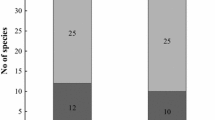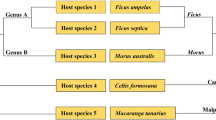Abstract
Ten leaves from each of 13 different tree types from two differentrainforest sites in North Queensland, Australia were examined in order toestablish the fungal diversity developing on these leaves. A total of 57microfungi were identified, most of which were mitosporic fungi. Speciesdiversity in terms of richness and evenness were compared and the Mt Lewis sitewas found to be richer as compared to the Butchers Creek site. Statisticalmeasurements of diversity indices, however, showed that the two forest siteswere of similar diversity. Thirty-six of the fungi identified occurred only onone leaf type, indicating possible host specificities or recurrences. The samplesize, however, is deemed to be insufficient, as a larger sample size may haveresulted in less of the fungi appearing to be host specific. It is recommendedthat future studies should include more leaf samples and less tree types. It isparticularly important that the same leaf species are collected within the samesite and at different sites in order to establish the effects of host on fungalcomposition.
Similar content being viewed by others
References
Aptroot A. 1997. Species diversity in tropical rainforest ascomycetes: lichenized versus non-lichenized; foliicolous versus corticolous. Abstracta Botanica 21: 37-44.
Bills F.G. 1995. Analyses of microfungal diversity from a user' perspective. Canadian Journal of Botany 73: S33-S41.
Bills G.F. and Polishook J.D. 1994a. Abundance and diversity of microfungi in leaf litter of a lowland rainforest in Costa Rica. Mycologia 86: 187-198.
Bills G.F. and Polishook J.D. 1994b. Microfungi from decaying leaves of Heliconia mariae (Heliconiaceae). Brenesia 41-42: 27-43.
Bogan B.W., Schoenike B., Lamar R.T. and Cullen D. 1996. Manganese peroxidase mRNA and enzyme activity levels during bioremediation of polyaromatic hydrocarbon-contaminated soil with Phanerochaete chrysosporium. Applied and Environmental Microbiology 62: 2381-2386.
Cooke R.C. and Rayner A.D.M. 1984. Ecology of Saprotrophic Fungi. Longman Group, London.
Fröhlich J. and Hyde K.D. 1999. Biodiversity of palm fungi in the tropics: are global fungal diversity estimates realistic? Biodiversity and Conservation 8: 977-1004.
Guo L.D., Hyde K.D. and Liew E.C. 1998. A method to promote sporulation in palm endophytic fungi. Fungal Diversity 1: 109-113.
Guo L.D., Hyde K.D. and Liew E.C.Y. 2000. Identification of endophytic fungi from Livistona chinensis based on morphology and rDNA sequences. New Phytologist147: 617-630.
Hawksworth D.L. 1990. The fungal dimension of biodiversity: magnitude, significance and conservation.Mycological Research 95: 641-655.
Hyde K.D. 2001. Increasing the likelihood of novel compound discovery from filamentous fungi. In: Pointing S.B. and Hyde K.D. (eds), Bio-exploitation of Filamentous Fungi. Fungal Diversity Research Series 6. Fungal Diversity Press, Hong Kong, pp. 77-91.
Lodge D.J. 1997. Factors related to diversity of decomposer fungi in tropical forests. Biodiversity and Conservation 6: 681-688.
Lodge D.J. and Cantrell S. 1995. Fungal communities in wet tropical forests: variation in time and space. Canadian Journal of Botany 73: S1391-S1398.
Magurran A.E. 1988. Ecological Diversity and Its Measurement. Princeton University Press, Princeton, New Jersey.
May R.M. 1994. Conceptual aspects of the quantification of the extent of biological diversity. Philosophical Transactions of the Royal Society of London B 345: 13-20.
Polishook J.D., Bills G.F. and Lodge D.J. 1996. Microfungi from decaying leaves of two rainforest trees in Puerto Rico. Journal of Industrial Microbiology 17: 284-294.
Redlin S.C. and Carris L.M. 1996. Endophytic Fungi in Grasses and Woody Plants. APS Press, St Paul, Minnesota.
Senior D.J., Mayers P.R. and Saddler J.N. 1991. The interaction of xylanases with commercial pulps. Biotechnology and Bioengineering 37: 274-279.
Shivas R.G. and Hyde K.D. 1997. Biodiversity of plant pathogenic fungi in the tropics. In: Hyde K.D. (ed.), Biodiversity of Tropical Microfungi. Hong Kong University Press, Hong Kong, pp. 47-56.
Taylor J.E., Hyde K.D. and Jones E.B.G. 1999. Endophytic fungi associated with the temperate palm Trachycarpus fortunei within and outside its natural geographic range. New Phytologist 142: 335-346.
Tracey J.G. 1982. The Vegetation of the Humid Tropical Region of North Queensland. CSIRO, Melbourne, Australia.
Zar J.H. 1996. Biostatistical Analysis. 3rd edn. Prentice Hall, Englewood Cliffs, New Jersey.
Author information
Authors and Affiliations
Rights and permissions
About this article
Cite this article
Parungao, M.M., Fryar, S.C. & Hyde, K.D. Diversity of fungi on rainforest litter in North Queensland, Australia. Biodiversity and Conservation 11, 1185–1194 (2002). https://doi.org/10.1023/A:1016089220042
Issue Date:
DOI: https://doi.org/10.1023/A:1016089220042




